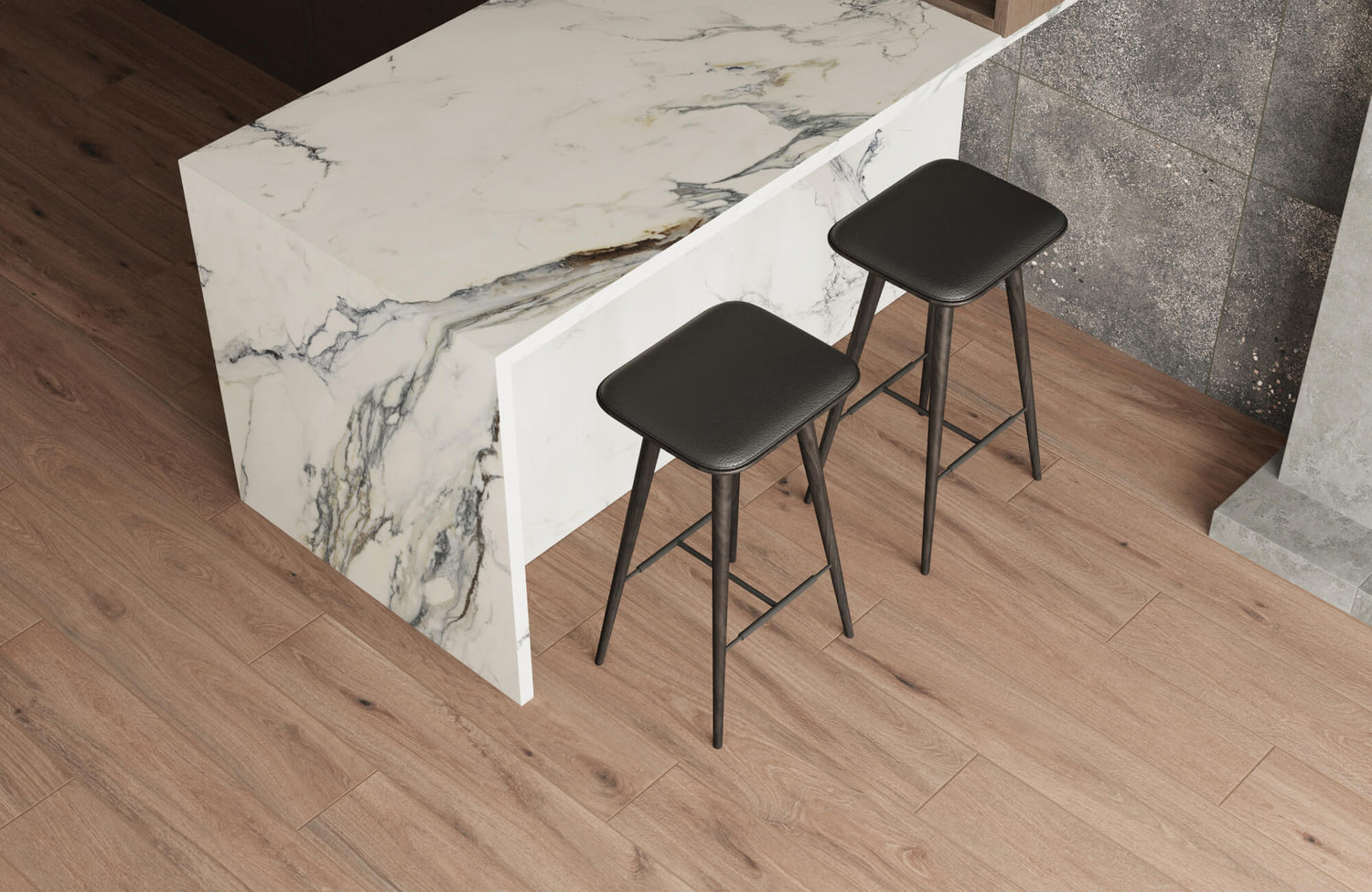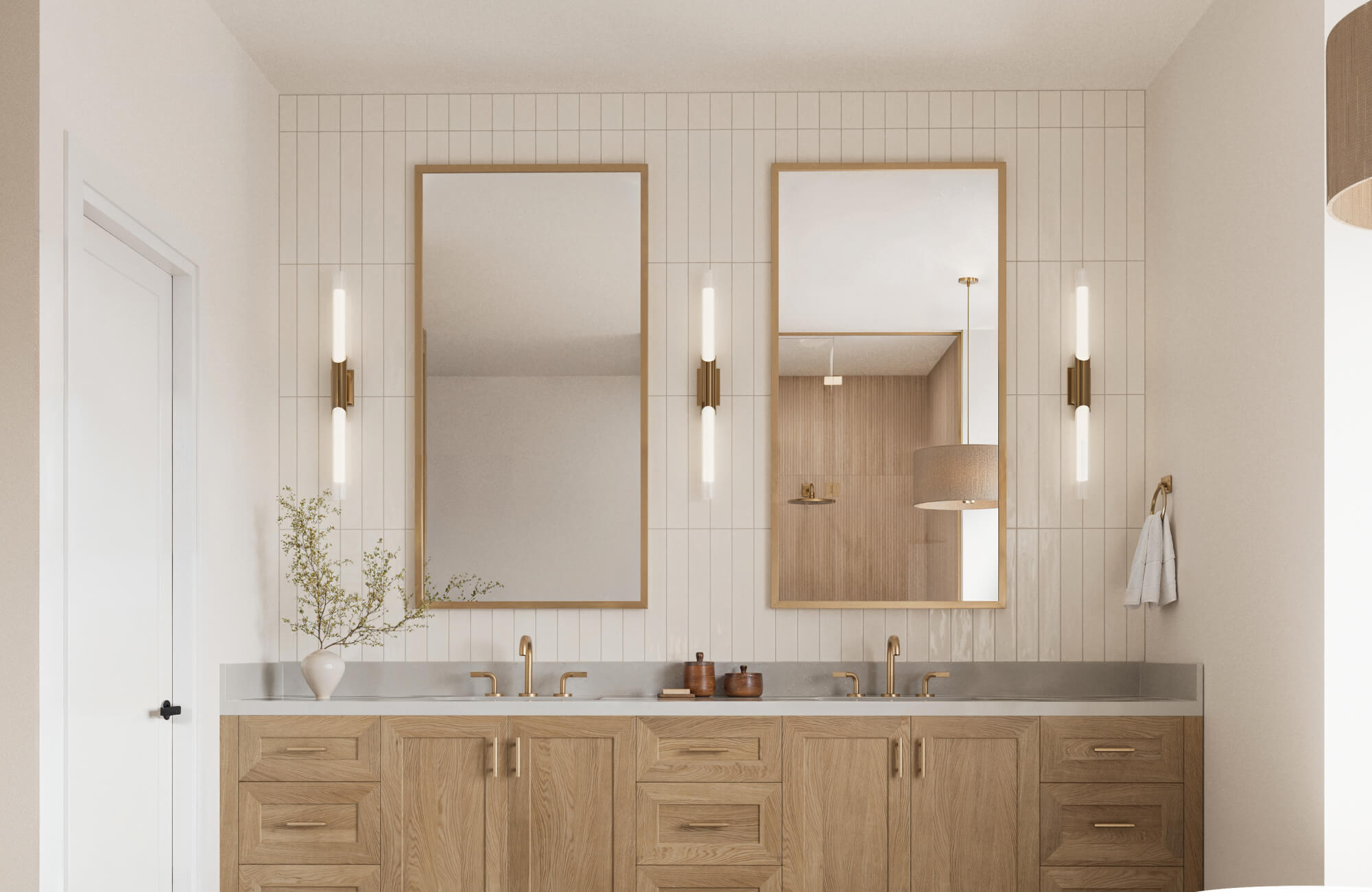Wood-look tiles and vinyl flooring have gained significant popularity as stylish alternatives to traditional hardwood. With impressive advancements in design and materials, these options effectively replicate the timeless beauty of wood while offering exceptional durability and low-maintenance care. This growing trend reflects a keen interest in finding stylish floor solutions that accommodate diverse lifestyles and budgets.
Selecting the right flooring is essential, as it influences the durability, comfort, and aesthetic appeal of your lovely living space. In this guide, we will explore the key features, benefits, and considerations of wood-look tiles and vinyl flooring, helping you make an informed and confident decision for your home.
Material Composition and Appearance
Understanding the composition and appearance of wood-look tiles and vinyl flooring can help you decide which material will work best in your space. We'll go over the key aspects of each to help you make an informed decision.
Wood-Look Tiles
Wood-look tiles are a popular alternative to traditional hardwood, providing the appearance of wood while avoiding some of its disadvantages. Here are some important aspects of their composition and functionality:
Materials
Wood-look tiles, which are typically made of ceramic or porcelain, accurately replicate natural wood grain and texture while providing impressive durability. Their strong material composition allows them to withstand daily wear and tear.
Finishes
They closely resemble different wood species and are available in a variety of finishes, including matte, polished, and textured, giving you a range of aesthetic options to suit your style. This versatility allows for seamless integration into a range of interior designs.
Best Applications
Wood-look tiles are ideal for moisture-prone areas such as kitchens and bathrooms, as they provide excellent water resistance and long-term durability. For example, Edward Martin’s Preston 8x48 Matte Porcelain Tile in Pine, as shown in the photo above, gives you that beautiful pine wood look while easily handling humidity. However, it is important to note that they can feel colder and harder underfoot than other flooring options, which may affect comfort.
Vinyl Flooring
Vinyl flooring has become a go-to option for many homeowners seeking a balance between aesthetics and practicality. Here’s what you need to know about its structure and appeal:
Materials
Vinyl flooring types such as Stone Plastic Composite (SPC) and Wood Plastic Composite (WPC) are made up of multiple layers, including a wear layer and core, and provide excellent flexibility and comfort underfoot. This multi-layer construction also improves overall durability and resilience.
Designs
Vinyl is designed to be quieter and warmer underfoot, which gives a more comfortable walking experience. With a variety of patterns and colors, it closely resembles real wood, which allows for a wide range of design options in any room.
Best Applications
Vinyl flooring is ideal for moderately busy areas, but it may be more prone to scratches and dents compared to porcelain floor tiles. This makes it ideal for spaces with low-impact use, such as bedrooms or home offices, where comfort and warmth are important.
Durability and Longevity
When choosing flooring, durability and longevity are critical considerations because they have a direct impact on the maintenance and lifespan of your investment. The following is a comparison of wood-look tiles and vinyl flooring in terms of wear resistance and overall durability.
Wood-Look Tiles
As previously highlighted, wood-look tiles are designed for durability, making them an excellent choice for various spaces due to their resistance to scratches and moisture. Here are the key points regarding their longevity:
Strong Resistance
Wood-look tiles, particularly those crafted from porcelain, are highly resistant to scratches, water, and heavy use, which allows them to withstand daily wear. Their strong material composition ensures that they retain their appearance over time, making them a durable flooring option.
Limitations
Despite their durability, they can chip or crack when subjected to heavy forces. While they are designed to withstand heavy loads, dropping them can cause damage that may necessitate replacement.
Overall Lifespan
With proper installation and care, wood-look tiles can last for decades, providing both aesthetic appeal and functional reliability, particularly in frequently used areas. Plus, their low-maintenance nature means you can enjoy the beauty of hardwood without the hassle of constant upkeep.
Vinyl Flooring
Vinyl flooring is also known for its versatility and durability, making it a popular choice for families and pet owners. Here’s what to know about its longevity:
Strong Resistance
Vinyl flooring is highly resistant to dents, scratches, and daily wear, making it ideal for areas with heavy usage and pet-friendly environments. Its multi-layered structure, which includes a wear layer for protection and a core layer for stability, adds strength and resilience to everyday household activities while ensuring a comfortable underfoot feel.
Limitations
However, vinyl is prone to tears under sharp objects and may fade if exposed to direct sunlight for an extended period of time. While it can withstand everyday use, care should be taken to avoid damage from heavy furniture or sharp edges.
Overall Lifespan
With proper care, vinyl flooring can last 10 to 20 years, depending on the product's quality and the amount of usage that it receives. Regular cleaning and maintenance can help to maintain its appearance and functionality over time.

Installation Process
The installation process can significantly influence the overall cost and effort involved in flooring projects. Understanding the methods and requirements for both wood-look tiles and vinyl flooring will allow you to make an informed decision.
Wood-Look Tiles
Wood-look tiles are known for their aesthetic appeal, but their installation process can be complex and often requires professional expertise. Here are the key points to consider:
Common Methods
Mortar and grout are typically used during installation to secure the tiles and give them a finished appearance. This method guarantees stability and durability, but it necessitates meticulous attention to detail during application.
Professional Installation
Because of the complexity of the installation, it is often recommended that you hire professionals. Their knowledge can help you avoid common pitfalls and achieve a high-quality finish, particularly in intricate patterns.
Time and Cost Considerations
Installing wood-look tiles can be time-consuming, often taking several days depending on the project size. In addition, costs can vary significantly, with professional installation fees adding to the overall expense.
If you want to see how the right wood-look tile can transform your space, use our augmented reality (AR) tool to view different colors and finishes in real-time. It's a great way to test out different options and see how each tile choice affects your interior design before making a final decision.
Vinyl Flooring
Vinyl flooring offers a more straightforward installation process, making it accessible for DIY enthusiasts. This not only saves money but also allows for greater flexibility in choosing a design that suits their unique style and preferences. Here’s what to know about its installation:
Installation Methods
Vinyl flooring can often be available in simple click-and-lock or glue-down installations. These simple options are easy to assemble and can be installed over existing flooring, making the process more efficient.
DIY Suitability
Vinyl flooring is an affordable option for those looking to cut labor costs due to its ease of installation. Homeowners can complete the project themselves with minimal tools and experience.
Time Commitment
Vinyl flooring installation takes less time than wood-look tiles, and can often be completed in a single day for small areas. This can significantly reduce the overall project timeline, allowing you to start enjoying your new flooring sooner.
Environmental Impact
When it comes to flooring options, the environmental impact and sustainability of the materials used are becoming increasingly important. The following is a summary of the environmental impact of wood-look tiles and vinyl flooring.
Wood-Look Tiles
Wood-look tiles are often seen as a more sustainable flooring option due to their durability and low environmental impact. The following are the key points to consider when evaluating wood-look tiles for sustainability:
Sustainability
Wood-look tiles generally have a longer lifespan compared to many other flooring materials, which reduces the need for frequent replacements. This durability contributes to a lower overall environmental footprint over time.
Environmentally Friendly Materials
Many wood-look tiles are made from environmentally friendly materials, such as porcelain, which is produced from natural clay. Porcelain tiles are often fired at high temperatures, making them durable and resistant to wear while minimizing the need for chemical additives.
Recyclability
Many porcelain and ceramic tiles can be recycled when they reach the end of their useful life, further enhancing their sustainability. This feature makes wood-look tiles a sensible choice for environmentally-conscious homeowners.
Vinyl Flooring
Vinyl flooring has advantages and disadvantages in terms of environmental impact. While newer versions are made with more environmentally friendly practices, concerns about recyclability and manufacturing processes persist. Here’s a closer look at the key environmental factors to consider when choosing vinyl flooring:
Potential Environmental Concerns
Traditional vinyl flooring is made of polyvinyl chloride (PVC), which raises concerns about its environmental impact during production and disposal. The manufacturing process can produce harmful chemicals, and vinyl flooring is not biodegradable, causing concerns about landfill waste.
Eco-Friendly Developments
However, there have been significant advances in environmentally friendly vinyl options. Many manufacturers are now producing vinyl flooring with a lower environmental impact, including recycled materials and fewer hazardous additives. This development gives consumers more sustainable options.
Sustainability Considerations
When choosing vinyl flooring, look for certifications and labels that indicate eco-friendly practices, such as FloorScore or GreenGuard. These certifications can help ensure that the product complies with environmental standards and contributes towards better indoor air quality.
Aesthetic Appeal
When selecting flooring, think of aesthetic appeal to complement your interior design. Both wood-look tiles and vinyl flooring have distinct advantages in this regard, with wood-look tiles providing a realistic, authentic grain that mimics natural hardwood, and vinyl flooring offering versatile patterns and color options to suit various styles.
Wood-Look Tiles
As previously highlighted, wood-look tiles are designed to replicate the natural beauty of hardwood flooring, with realistic grain patterns and textures that create a timeless look. These types of tiles, made of durable materials such as ceramic or porcelain, provide not only visual appeal but also the strength and resilience required in areas with heavy use. Wood-look tiles are also often a more realistic option than vinyl, with the depth and organic feel of genuine wood. This makes them ideal for high-end residential, commercial, and affordable luxury homes where authenticity is important.
For example, the Preston 8x48 Matte Porcelain Tile in Chestnut has a deep chestnut hue and authentic wood grain details that capture the warmth and character of natural wood planks. Its matte finish enhances the organic feel, making it an excellent choice for anyone looking for the charm of wood without the maintenance requirements of real hardwood.
Vinyl Flooring
Vinyl flooring is known for its remarkable versatility, with a wide range of colors, patterns, and styles to suit any interior design theme. Vinyl options can look like wood, stone, or intricate tile designs, providing aesthetic flexibility at a more accessible price point, which makes it especially popular in rental properties, apartments, and homes needing cost-effective style updates.
Its softer and warmer underfoot feel also improves comfort, particularly in living areas and children's rooms. While vinyl is a popular choice among homeowners, it is important to choose high-quality products to ensure your desired appearance and durability over time.
Making the Right Flooring Choice
Wood-look tiles and vinyl flooring are both great options, each with its own set of advantages and disadvantages. They have a realistic hardwood appearance and superior durability, making them ideal for areas with heavy use while also providing a timeless look. Vinyl flooring, on the other hand, stands out for its design versatility, affordability, and ease of installation, making it a popular choice for cost-conscious homeowners or those looking to do it themselves.
Ultimately, the best flooring option will be determined by your specific needs and lifestyle. When making a decision, consider how busy your home is, your budget, and your aesthetic preferences. By evaluating these key points, you will be able to confidently choose the flooring that best fits your space and complements your overall design. For any questions or personalized guidance, don’t hesitate to contact us! Our team is here to assist you through each step of your wood-look tile selection and installation, helping you achieve the ideal style and durability for your space.











